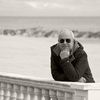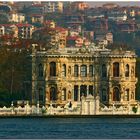At the Asian shore of the Bosphorus
6 d'abril de 2007, a les 19:16h
Canon EOS 300D
Objectiu Canon EF 70-300mm f/4.6-5.6 DO IS USM
1/400 f/5.0 ISO100 DF170mm
Küçüksu Sarayi is a palace situated in Beykoz district, at the Asian shore of Bosphorus between Anadoluhisarı and Fatih Sultan Mehmet Bridge today. The tiny palace was used by Ottoman sultans for short stays during country excursions and hunting.
The palace was commissioned by Sultan Abd-ul-Mejid (1823-1861), and designed and constructed by the Armenian-Turkish architects Garabet Amira Balyan and his son Nigoğayos Balyan in baroque style. A two storey timber palace on the waterfront here, built during the reign of Mahmud I (1696- 1754), gave place to the new palace, which was completed in 1857.
The building consists of two main stories and a basement on a ground area of 15 x 27 m. Unlike other palace gardens with high walls; its garden is surrounded by cast iron railings with one gate at each of the four sides. The basement was provided for kitchen, larder and quarters for servants. The above floors reflect the design of a traditional Turkish house so that four rooms in the corners surround a hall in the middle. The rooms at the waterfront have two fireplaces while other rooms having only one. The fireplaces were made out of colourful marble brought from Italy. The rooms have crystal chandeliers from Bohemia. The halls and the rooms exhibit valuable paintings and arts objects. Sechan, stage designer at Vienna State Opera, was charged for the decoration of the interior.
During the reign of Sultan Abd-ul-Aziz (1830-1876), more elaborate decoration was added to the façade. Some of the original additional buildings in the garden of the palace were demolished since then. In the beginning of the Republican era, the site was used as a state guesthouse for some years. After a thoroughly restoration in 1944, Küçüksu Palace is open to the public as a museum today.










Sonja So. 18/08/2010 17:49
Damals, hat man sich noch richtig Mühe gemacht beim Bauen.Wonderfull!!
LG Sonja
Creativo Zorton 08/05/2010 11:50
Fabulosa fotografía.Saludos.
Charly Roggow 01/05/2010 12:55
Bonita composición y colorsaludos Charly
dolores coll 01/05/2010 8:54
me gusta esta luz que parece estar colaborando contigo bañando el edificio y la verja.Rosa M. 29/04/2010 18:17
Precioso edificio y una luz magnífica.Un abrazo
Elfriede de Leeuw 29/04/2010 17:50
Wonderful houses!!!Very lovely.
Best wishes Elfriede
ferran petit 28/04/2010 19:02
quina bellesa!!!Sylvi1302 28/04/2010 9:11
Ein prachtvolles Gebäude !!!Schöne Ansicht !
LG Sylvi
Helga Noll 28/04/2010 8:00
Sehr beeindruckend ist das Foto mit der informativen Beschreibung des wundervollen Gebäudes. Danke! Liebe Grüße HelgaAdele D. Oliver 27/04/2010 23:39
What contrasts between the ornate old palace and the new houses in the hills .. ... a beautiful image, well lit, nice colours. And thank you for all the interesting information.cheers, Adele
Juan Villalobos Cabrera 27/04/2010 23:39
Una bella imagen de un lugar prodiogioso.Una abrazo.
Brilu 27/04/2010 21:59
Ein ganz wunderschönes Gebäude und eine sehr gute Beschreibung von Dir! HG BrigitteYacarandá 27/04/2010 19:44
Wow... a veces no hacen falta plabras... Un besoNicole Casutt 27/04/2010 19:23
Muy preciosa foto !!!Un palacio impressionante ...
Saludos, Nicole
Ramon Gamell 27/04/2010 18:48
Quina enveja de viatge... aquest 2007 !!!Té una llum especial. Molt maca.
Una abraçada.